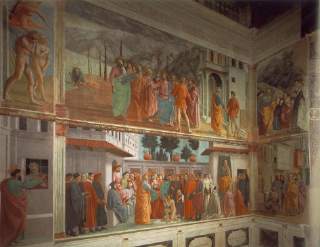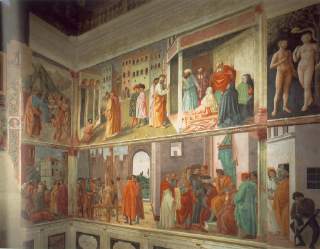
Web Gallery of Art
Not what man knows but what man feels, concerns
art. All else is science.
(Bernard Berenson, 1897)
It is assumed that work on the frescoes began in 1424, at a time when Masaccio and Masolino were working together, and that it continued until 1427 or 1428, when Masaccio set off for Rome, leaving the fresco cycle unfinished.
The appearence of the chapel today is the result of alterations begun immediately after Felice Brancacci fell out of favour; he was exiled in 1435 and declared a rebel in 1458. Further changes were carried out in the 18th and 19th centuries.
 |
Originally the chapel was cross-vaulted and lit by a very tall and narrow two-light window; the last of the stories from the life of St Peter, his Crucifixion, was probably painted on the wall below the window, but this fresco was destroyed soon after Brancacci was declared a rebel so as to cancel all traces of a patron who had become politically embarassing. The chapel, formerly the chapel of St Peter, was reconsacrated to the Madonna del Popolo. It appears that Felice Brancacci was subjected to an operation of "damnatio memoriae", for all the portrayals of people connected to the Brancacci family were eliminated from Masaccio's fresco of the Raising of the Son of Theophilus. The scene was then restored in 1481-82 by Filippino Lippi, who also completed the cycle. |
After the chapel was reconsacrated to the Virgin a number of votive lamps were installed: the lampblack they produced coated the surface of the frescoes, causing such damage that as early as the second half of the 16th century they had to be cleaned.
In 1670 further alterations were carried out: the two levels of frescoes were divided by four sculptures set in carved and gilded wooden frames. It was probably at this time that the leaves were added to conceal the nudity of Adam and Eve in the two frescoes, Masolino's Temptation and Masaccio's Expulsion from the Garden. This was probably conceived during the reign of the bigoted Cosimo III.
After several events, including a fire in 1771, a restoration combined with a thorough scientific investigation in the last decades brought the chapel to the state in which we can visit it nowadays.
The fresco cycle, with the exception of the first two, tells the story of St Peter, as follows:
Temptation (Masolino)
Expulsion from the Garden (Masaccio)
Tribute Money (Masaccio)
Healing of the Cripple and Raising of Tabitha
(Masolino)
St Peter Preaching (Masolino)
Baptism of the Neophytes (Masaccio)
St Peter Healing the Sick with his Shadow (Masaccio)
Distribution of Alms and Death of Ananias (Masaccio)
Raising of the Son of Theophilus and St Peter
Enthroned (Masaccio and Filippino Lippi)
St Paul Visiting St Peter in Prison (Filippino
Lippi)
Peter Being Freed from Prison (Filippino Lippi)
Disputation with Simon Magus and Crucifixion
of St Peter (Filippino Lippi)